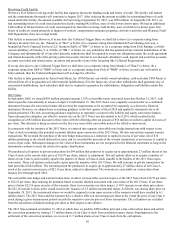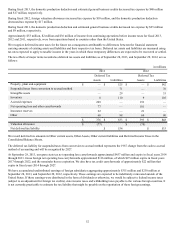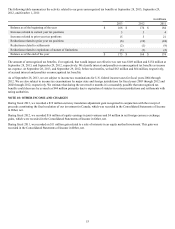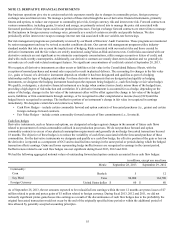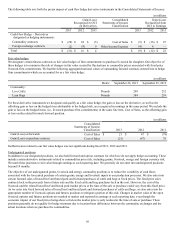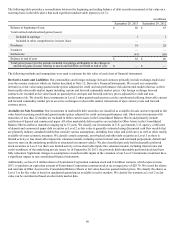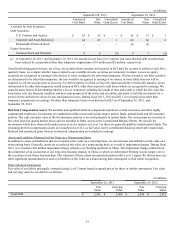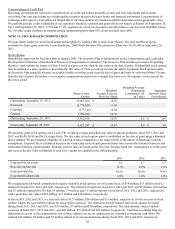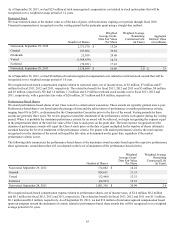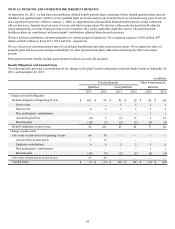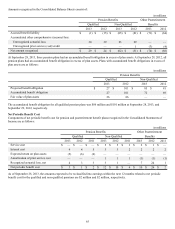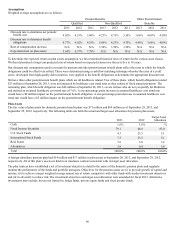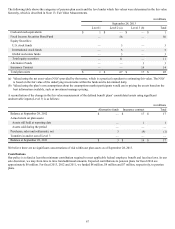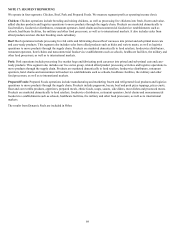Tyson Foods 2013 Annual Report Download - page 60
Download and view the complete annual report
Please find page 60 of the 2013 Tyson Foods annual report below. You can navigate through the pages in the report by either clicking on the pages listed below, or by using the keyword search tool below to find specific information within the annual report.
60
The following table provides a reconciliation between the beginning and ending balance of debt securities measured at fair value on a
recurring basis in the table above that used significant unobservable inputs (Level 3):
in millions
September 28, 2013 September 29, 2012
Balance at beginning of year $ 86 $ 83
Total realized and unrealized gains (losses):
Included in earnings 1 1
Included in other comprehensive income (loss) — —
Purchases 19 28
Issuances — —
Settlements (41) (26)
Balance at end of year $ 65 $ 86
Total gains (losses) for the periods included in earnings attributable to the change in
unrealized gains (losses) relating to assets and liabilities still held at end of year $ — $ —
The following methods and assumptions were used to estimate the fair value of each class of financial instrument:
Derivative Assets and Liabilities: Our commodities and foreign exchange forward contracts primarily include exchange-traded and
over-the-counter contracts which are further described in Note 12: Derivative Financial Instruments. We record our commodity
derivatives at fair value using quoted market prices adjusted for credit and non-performance risk and internal models that use as their
basis readily observable market inputs including current and forward commodity market prices. Our foreign exchange forward
contracts are recorded at fair value based on quoted prices and spot and forward currency prices adjusted for credit and non-
performance risk. We classify these instruments in Level 2 when quoted market prices can be corroborated utilizing observable current
and forward commodity market prices on active exchanges or observable market transactions of spot currency rates and forward
currency prices.
Available for Sale Securities: Our investments in marketable debt securities are classified as available-for-sale and are reported at fair
value based on pricing models and quoted market prices adjusted for credit and non-performance risk. Short-term investments with
maturities of less than 12 months are included in Other current assets in the Consolidated Balance Sheets and primarily include
certificates of deposit and commercial paper. All other marketable debt securities are included in Other Assets in the Consolidated
Balance Sheets and have maturities ranging up to 35 years. We classify our investments in U.S. government, U.S. agency, certificates
of deposit and commercial paper debt securities as Level 2 as fair value is generally estimated using discounted cash flow models that
are primarily industry-standard models that consider various assumptions, including time value and yield curve as well as other readily
available relevant economic measures. We classify certain corporate, asset-backed and other debt securities as Level 3 as there is
limited activity or less observable inputs into valuation models, including current interest rates and estimated prepayment, default and
recovery rates on the underlying portfolio or structured investment vehicle. We also classified privately held redeemable preferred
stock securities as Level 3 as there was limited activity or less observable inputs into valuation models, including interest rates and
credit worthiness of the underlying private issuer. As of September 28, 2013, the privately held redeemable preferred stock had been
fully redeemed. Significant changes to assumptions or unobservable inputs in the valuation of our Level 3 instruments would not have
a significant impact to our consolidated financial statements.
Additionally, we have 0.8 million shares of Syntroleum Corporation common stock and 0.4 million warrants, which expire in June
2015, to purchase an equivalent amount of Syntroleum Corporation common stock at an average price of $28.70. We record the shares
and warrants in Other Assets in the Consolidated Balance Sheets at fair value based on quoted market prices. We classify the shares as
Level 1 as the fair value is based on unadjusted quoted prices available in active markets. We classify the warrants as Level 2 as fair
value can be corroborated based on observable market data.


